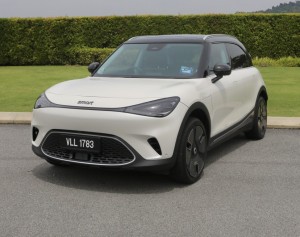Matrix headlights: A useful car feature - but with some downsides
By DPA | 01 February 2025
MUNICH: Headlight technology has made huge strides in recent decades. After halogen bulbs were the standard for a long time, xenon headlights brought significantly more light onto the road in the early 1990s. They were then replaced by even brighter LED lights.
Today more and more vehicle manufacturers offer intelligent LED matrix lighting that automatically adapts to the environment, which means that drivers no longer have to switch between dipped and high beams. However, what sounds simple and convenient does have some pitfalls in practice.
LED light consists of individual points of light. In a matrix light, which is usually used as a high beam, a large number of LEDs are combined to form a kind of "carpet of light."
Depending on the manufacturer, that can be more than 100 LEDs per headlight.
When the individual points of light are switched on is controlled by camera sensors. "Matrix light basically works like a projector," says Burkhard Böttcher from German motoring organisation ADAC. "Where the camera sensor detects an object, the light is switched off."
As a result, drivers have a much better illuminated road. Matrix headlights are also known as adaptive headlights because they automatically adjust the light to the current driving situation.
"If an obstacle is detected, the system switches off the points of light in this area in a fraction of a second," says Philipp Mathey from German auto club ACV.
"The more light points there are, the more precisely the light can be controlled, which leads to maximum light output. Oncoming vehicles or pedestrians can be virtually avoided by the headlights, while the road remains optimally illuminated."
In contrast to the classic high beam, which always has to be switched off completely, matrix lighting remains active and flexible.
Many matrix headlights also have a cornering light function. Even if the matrix light ignores an oncoming vehicle in a bend, the road to the right and left of it is still fully illuminated.
However, there are disadvantages. In Böttcher's opinion, the reaction times of the matrix systems are not yet optimal.
"A study by Porsche on this found that the reaction time of the lighting systems is 1 to 2 seconds longer than the human reaction time," he says.
That means that road users can be blinded when they drive towards a vehicle with matrix lighting. Truck drivers in particular are often the victims. "This is due to their elevated seating position, which is not detected and ignored by the camera sensors," explains Böttcher.
While it would be very expensive to retrofit LED matrix lighting to a car, it’s much less problematic to convert normal headlights from halogen to LED bulbs.
If you chose to do so, make sure that the LEDs are approved for your vehicle model. The relevant compatibility lists can be found on the websites of the lamp manufacturers. LEDs can be bought for around €100/US$100, according to ADAC, and can also be installed by laypeople.
But in the case of problems with LED matrix lighting it’s not simply a case of the layperson changing the bulb. "Repairs are expensive because defective LEDs cannot be replaced individually and often the entire headlight unit has to be replaced," according to Mathey.
In general, however, LED headlights are considered to be very durable and therefore have a higher energy efficiency compared to halogen or xenon headlights.
"This reduces the probability of failure and lowers maintenance costs, which makes the technology a more sustainable option in vehicle lighting," Mathey says.
Tags
Autos News
Reviews

7.9
Xpeng G6 580 Pro: Fresh and fluidic

Guangzhou adventures: Zontes 368 scooter and 703 Adventure m...

Zontes motorcycle factory in Jiangmen: Running on a fast tra...

7.6
Maserati GranTurismo (Mk2) Modena: Sharp and smooth operator

6.8
Triumph Tiger 900 GT Pro: Multi-talented adventurer

Hyundai Ioniq 5 N: Born rascal

6.6
Husqvarna Svartpilen 401: Inspiring retro design

8.8
smart #1 (Premium): Agile, engaging, roomy, premium motoring
Videos

StarCarSifu Editors' Choice Awards 2024: Top winners

The Snowball – Lamborghini’s Heartwarming Christmas Story of...

EVOGO battery swapping solution showcased at IAA Mobility 20...
